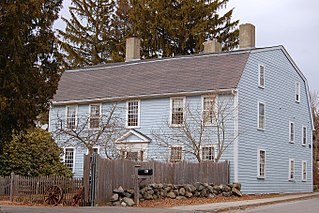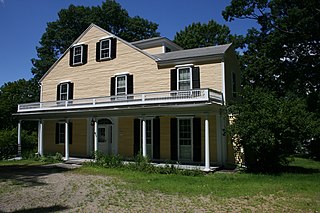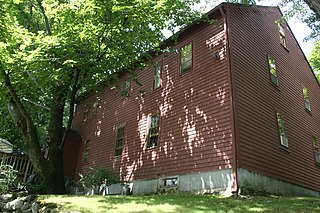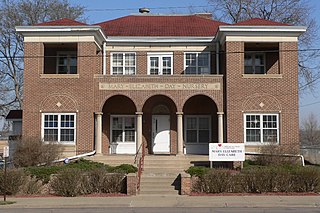
The Colonel John Ashley House is a historic house museum at 117 Cooper Hill Road in Sheffield, Massachusetts. Built in 1735 by a prominent local leader, it is one of the oldest houses in southern Berkshire County. The museum is owned and operated by The Trustees of Reservations, and is listed on the National Register of Historic Places.

Tudor Place is a Federal-style mansion in Washington, D.C. that was originally the home of Thomas Peter and his wife, Martha Parke Custis Peter, a granddaughter of Martha Washington. The property, comprising one city block on the crest of Georgetown Heights, had an excellent view of the Potomac River.

Edward Franc Jones was an American merchant, manufacturer, soldier, author and politician from New York.

The Durant-Kenrick House and Grounds is a historic late First Period house at 286 Waverly Avenue in Newton Centre, Massachusetts, that is now a historic house museum.

The Wadsworth Mansion at Long Hill Estate is located at 421 Wadsworth Street in Middletown, Connecticut. It is a 16,000-square-foot (1,500 m2) classical revival house situated on 103 acres (0.42 km2) wooded area. It is currently owned by the City of Middletown and is operated by the Long Hill Estate Authority. The mansion is the centerpiece of the Wadsworth Estate Historic District of 270 acres (1.1 km2), which includes the mansion's associated outbuildings, the Middletown portion of Wadsworth Falls State Park, the Nehemiah Hubbard House, and several barns and farmhouses along Laurel Grove Road such as the Harriet Cooper Lane House.

The Timothy P. Bailey House is a historic house in Andover, Massachusetts. It was built by Timothy Palmer Bailey, on land purchased from his father's estate. The Baileys were successful farmers, and the younger one, who was educated at Phillips Academy, built this locally rare example of an Italianate house in 1878. The 2+1⁄2-story L-shaped house features bracketed cornices, and a main entrance porch that is elaborately balustraded and also bracketed.

The Chestnut Street District is a historic district bounded roughly by Bridge, Lynn, Beckford, and River Streets in Salem, Massachusetts. It was added to the National Register of Historic Places in 1973 and enlarged slightly in 1978. The district contains a number of architecturally significant works of Samuel McIntire, a builder and woodworker who had a house and workshop at 31 Summer Street, and who designed and built a number of these houses, and others that display the profits made in the Old China Trade by Salem's merchants. The district is a subset of a larger locally designated McIntire Historic District.

Fort Pickering is a 17th-century historic fort site on Winter Island in Salem, Massachusetts. Fort Pickering operated as a strategic coastal defense and military barracks for Salem Harbor during a variety of periods, serving as a fortification from the Anglo-Dutch Wars through World War II. Construction of the original fort began in 1643 and it saw use as a military installation into the 20th century. Fort Miller in Marblehead also defended Salem's harbor from the 1630s through the American Civil War. Fort Pickering is a First System fortification named for Colonel Timothy Pickering, born in Salem, adjutant general of the Continental Army and secretary of war in 1795. Today, the remains of the fort are open to the public as part of the Winter Island Maritime Park, operated by the City of Salem.

The Capt. Timothy Johnson House is a historic late First Period house in North Andover, Massachusetts. The 2+1⁄2-story wood-frame gambrel-roofed house was built ca. 1720 by Timothy Johnson, a leading Andover resident who led Massachusetts troops in the 1745 Siege of Louisbourg. The building has a wealth of well-preserved first and second period Georgian detailing.

The James Putnam Jr. House is a historic First Period house in Danvers, Massachusetts. It is a 2+1⁄2-story wood-frame structure, five bays wide, with a gambrel roof pierced by three interior chimneys. The house was built in stages, beginning in about 1715 as a typical First Period double pile house, with a center entrance, chimney and winder staircase. To this another double pile structure was added to the front in the mid 1700’s creating an early Federal style central hall structure. This expansion was completed by the last Attorney General to King George III, who fled to Nova Scotia at the beginning of the Revolution. The house's most prominent Colonial resident was Colonel Timothy Pickering, who leased it from 1802 to 1804, when he was serving as United States Senator.

The Harnden Tavern, also known as the Col. Joshua Harnden Tavern, is a historic tavern that was built in 1770 at 430 Salem Street in Wilmington, Massachusetts.

16 Mineral Street in Reading, Massachusetts is a well-preserved Second Empire cottage. It was built c. 1874 and probably moved to its present location not long afterward, during a building boom in that part of the town. It was listed on the National Register of Historic Places in 1984.

The Jacob Manning House is a historic house in Reading, Massachusetts. Built in 1877 for garden nursery owner Jacob Manning, this 2+1⁄2-story wood-frame house is an excellent local example of Stick style architecture. It has a steeply pitched roof, multiple gables, tall thin windows, and decorative half-timber woodwork. The owner, Jacob Manning, owned one of the largest nurseries in the area, and was responsible for the landscaping of the Massachusetts pavilion at the 1893 Chicago World Fair.

The Timothy Hartshorn House is a historic house in Reading, Massachusetts. This 2+1⁄2-story wood-frame house was built c. 1787 by Timothy Hartshorn, a farmer and shoemaker, and remained in his family for over 100 years. It is a vernacular Georgian-Federal style, with five bays and a central chimney. The main entrance is flanked by sidelight windows and fluted pilasters, supporting an entablature with high capitals, but is somewhat obscured by the 19th century porch.

The Timothy Paine House, also known as The Oaks, is a historic house at 140 Lincoln Street in Worcester, Massachusetts. Built in the mid-1770s, it is one of the city's oldest buildings, and a good example of Georgian and Federal styling. It was built by Timothy Paine, a note local judge who fled during the American Revolution due to his Loyalist leanings. The house has been owned by the Colonel Timothy Bigelow Chapter of the Daughters of the American Revolution, since 1914 and uses it as a chapter house. It is open by for tours from May- October or by appointment. The house was listed on the National Register of Historic Places in 1976.

The John Jones House is a historic house at 1 Winthrop Street in Stoneham, Massachusetts. Built in 1874, it is a well-preserved example of a house with classic, yet modest, Italianate features. The two-story wood-frame structure is finished in clapboards, with a side-gable roof and twin interior chimneys. It has a three-bay front facade, with bay windows flanking a center entry that is sheltered by a porch connected to the bay roofs. John Jones, the first owner, was a shoemaker.

The Thomas W. Jones House is a historic house at 34 Warren Street in Stoneham, Massachusetts. It is Stoneham's best preserved Second Empire house, preserving significant external details, and its carriage house. The two-story wood-frame house has a T shape, and features a bracketed porch and cornice, gable screens, paneled pilasters, and oriel windows. The house was built for Thomas W. Jones, who built the last major shoe factory in Stoneham.

The Benjamin Flagg House is a historic house located at 136 Plantation Street in Worcester, Massachusetts. Built c. 1717, it is considered the oldest structure in the city. It was home to a number of generations of influential Flaggs, including American Revolutionary War Captain Benjamin Flagg (1724–1818). The house was listed on the National Register of Historic Places in 1980.

The Emerson–Franklin Poole House is a historic house at 23 Salem Street in Wakefield, Massachusetts. Built about 1795, it was in the 19th century home to Franklin Poole, a locally prominent landscape artist. Some of its walls are adorned with the murals drawn by Rufus Porter. The house was listed on the National Register of Historic Places in 1989.

Mary Elizabeth Day Nursery, also known as Mary Elizabeth Day Care Center, is a historic building located in Sioux City, Iowa, United States. This is the oldest child day care facility in the state of Iowa, and the state's second-oldest preschool. The Sioux City Day Nursery was established in 1914 by the Wall Street Mission, a local settlement house operated by the Methodist Episcopal Church. They moved here in 1926, which is the first building designed as a day nursery in Iowa. The two-story brick Renaissance Revival building was designed by local architect Jurgen A. Raven, and built by The Lytle Company, a Sioux City construction firm. Parents were responsible for paying for at least part of their children's care, but it was also subsidized by religious institutions, private associations, and individuals. During the Great Depression, both the federal and state governments began to fund and license child care. The Works Progress Administration was involved in the 1930s. A garage and playhouse designed by Sioux City architect Knute E. Westerlind was built in 1940, and it is part of the historic designation. The facility was renamed the Mary Elizabeth Day Care Center in 1990. The building was listed on the National Register of Historic Places in 1997.























